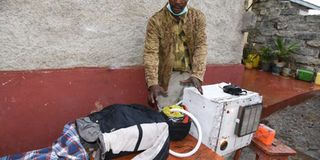Artisan makes spraying booth and a ventilator

Mr Stanley Ng'ang'a, a member of Mercy Rescue Divers in Eldoret, Uasin Gishu County, demonstrates how his ventilator works. PHOTO | JARED NYATAYA
What you need to know:
- Mr Ng’ang’a, a diver, borrowed ideas from diving equipment to come up with the machine that can help save lives.
- The machine has a compressor gauge, regulator, air cleaner, mortar, two motorcycle flywheel gears, a rubber diaphragm, pieces of wire, switches and pipes connected to an improvised lung (rubber tubes).
The machine is made up of conduit pipes fitted with 18 nozzles and a motor that is fixed to a container.
The Covid-19 pandemic has seen several Kenyans come up with innovations to battle the health crisis. In Eldoret, Uasin Gishu County, a man has come up with a ventilator, which he says can help health facilities deal with emergency cases.
Mr Stanley Ng’ang’a, a 38-year-old artisan from Kamukunji estate in Eldoret, started making a ventilator after the government admitted that hospitals had inadequate intensive care facilities and gadgets to help manage critical Covid-19 patients.
Mr Ng’ang’a, a diver whom the police in the area depend on to retrieve bodies of drowning victims, borrowed ideas from diving equipment to come up with the machine that can help save lives.
“I was worried when I heard that there were shortages of ventilators. Then I was motivated by the university students who came up with one and that is how I came up with this,” Mr Ng'ang'a told the Saturday nation.
The machine has a compressor gauge, regulator, air cleaner, mortar, two motorcycle flywheel gears, a rubber diaphragm, pieces of wire, switches and pipes connected to an improvised lung (rubber tubes).
Using natural air
Mr Ng’ang’a, while demonstrating how the innovation works, said it is powered by a 12-volt motorcycle battery but can as well be powered by electricity. When it is on, it can charge another battery which can run it for 12 hours.
“When it is switched on, the rotation of the mortar causes consistent contraction of the rubber diaphragm, which eventually pumps air in and out of the lungs because there is an inlet valve and an outlet valve,” Mr Ng’ang'a explained.
He said he used materials worth Sh3,000 to make the machine, which weighs 13kg and fits into a stainless steel box.
He says unlike the large ventilators in hospitals, his is small and works without oxygen cylinders – using natural air.
“This jua kali ventilator is a simple and easy-to-use machine. It requires minimal resources to produce, unlike ventilators in ICU facilities, which are complex and expensive,” says Mr Ng’ang’a.
The challenge for him, however, is getting approvals to produce the respiratory machine, so we couldn’t establish if it really works.
“I am requesting the government to send experts to assess this ventilator, then if I get approval, I can produce it for our hospitals,” he says.
Mr Ng’ang’a says the machine, like an ideal ventilator, expands a collapsed air sac in the lungs – also known as alveoli – allowing in air hence helping the patient with breathing problem.
“This machine uses the positive pressure mechanism, which increases pressure along the trachea (respiratory tract). With that pressure, it will make the collapsed alveoli to expand, letting in the air. I have tried using it and it works perfectly,” says Mr Ng’ang’a.
A few months ago, he came up with a machine in the design of the spraying booths installed at the Nairobi Railway Station and at the Likoni ferry crossing.
“During this pandemic, our medics are risking their lives for the sake of the health of this nation. Therefore, we need to have a machine that can disinfect them properly rather than the nozzle pumps being used currently and that is why I came up with a machine to help our frontline soldiers,” says Mr Ng’ang’a.
It uses electricity
The machine is made up of conduit pipes fitted with 18 nozzles and a motor that is fixed to a container.
The container has chemicals for disinfection and has the capacity for back flow in case the pressure is high. It uses electricity.
Mr Ng'ang'a says being an expert in spraying for over 20 years enabled him to put together the machine which he said he only used Sh10,000 to make.
"I have been in this spraying field for 21 years and I comprehend the kind of nozzle and pipes to use to come up with a booth," he says.
The spraying booth does not require any person going through it to touch anything for it to work. All they do is stand at the centre, which triggers the motor for the spraying to start.
According to him, there is no need for the government to import such machines yet artisans have numerous innovations which, if boosted, could solve many challenges.
He added that if he could get sufficient capital, he could come up with a complete spraying booth which can be placed at the entrance of every hospital, police stations, markets and prisons.
“The government should support jua kali people and the issue of importing certain things will no longer exist. Look at this machine. I have made it only for a week and I am planning to visit the Kenya Bureau of Standards (Kebs) to have it evaluated,” he says.
[email protected]; @onyangokonyango




